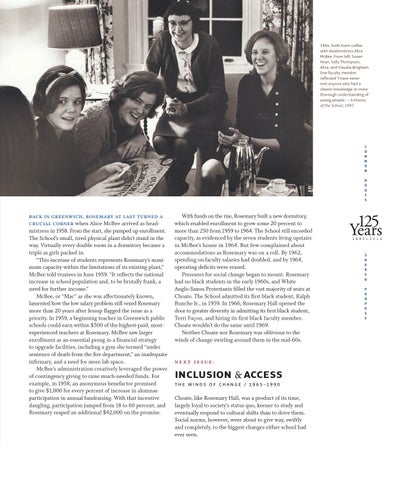1964, Sixth Form coffee with Headmistress Alice McBee. From left, Susan Heyn, Sally Thompson, Alice, and Claudia Bingham. One faculty member reflected "I have never met anyone who had a clearer knowledge or more thorough understanding of young people." – A History of the School, 1997.
c o m m o n r o o t s BACK IN GREENWICH, ROSEMARY AT LAST TURNED A CRUCIAL CORNER when Alice McBee arrived as head-
mistress in 1958. From the start, she pumped up enrollment. The School’s small, tired physical plant didn’t stand in the way. Virtually every double room in a dormitory became a triple as girls packed in. “This increase of students represents Rosemary’s maximum capacity within the limitations of its existing plant,” McBee told trustees in June 1959. “It reflects the national increase in school population and, to be brutally frank, a need for further income.” McBee, or “Mac” as she was affectionately known, lamented how the low salary problem still vexed Rosemary more than 20 years after Jessup flagged the issue as a priority. In 1959, a beginning teacher in Greenwich public schools could earn within $500 of the highest-paid, mostexperienced teachers at Rosemary. McBee saw larger enrollment as an essential prong in a financial strategy to upgrade facilities, including a gym she termed “under sentence of death from the fire department,” an inadequate infirmary, and a need for more lab space. McBee’s administration creatively leveraged the power of contingency giving to raise much-needed funds. For example, in 1958, an anonymous benefactor promised to give $1,000 for every percent of increase in alumnae participation in annual fundraising. With that incentive dangling, participation jumped from 18 to 60 percent, and Rosemary reaped an additional $42,000 on the promise.
With funds on the rise, Rosemary built a new dormitory, which enabled enrollment to grow some 20 percent to more than 250 from 1959 to 1964. The School still exceeded capacity, as evidenced by the seven students living upstairs in McBee’s house in 1964. But few complained about accommodations as Rosemary was on a roll. By 1962, spending on faculty salaries had doubled, and by 1964, operating deficits were erased. Pressures for social change began to mount. Rosemary had no black students in the early 1960s, and White Anglo-Saxon Protestants filled the vast majority of seats at Choate. The School admitted its first black student, Ralph Bunche Jr., in 1959. In 1966, Rosemary Hall opened the door to greater diversity in admitting its first black student, Terri Façon, and hiring its first black faculty member. Choate wouldn’t do the same until 1969. Neither Choate nor Rosemary was oblivious to the winds of change swirling around them in the mid-60s.
NEXT ISSUE:
inclusion & access the winds of change / 1965-1990
Choate, like Rosemary Hall, was a product of its time, largely loyal to society’s status quo, keener to study and eventually respond to cultural shifts than to drive them. Social norms, however, were about to give way, swiftly and completely, to the biggest changes either school had ever seen.
s h a r e d p u r p o s e
